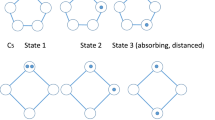Abstract
In this paper we consider the problem of capturing an intruder in a particular fractal graph, the Sierpiński graph SG n . The problem consists of having a team of mobile software agents that collaborate in order to capture the intruder. The intruder is a mobile entity that escapes from the team of agents, moving arbitrarily fast inside the network, i.e., traversing any number of contiguous nodes as long as no other agent resides on them. The agents move asynchronously and they know the network topology they are in is a Sierpiński graph SG n .
We first derive lower bounds on the minimum number of agents, number of moves and time steps required to capture the intruder. We then consider some variations of the model based on the capabilities of the agents: visibility, where the agents can “see” the state of their neighbors and thus can move autonomously; locality, where the agents can only access local information and thus their moves have to be coordinated by a leader. For each model, we design a capturing strategy and we make some observations. One of our goals is to continue a previous study on what is the impact of visibility on complexity: in this topology we are able to reach an optimal bound on the number of agents required by both cleaning strategies. However, the strategy in the visibility model is fully distributed, whereas the other strategy requires a leader. Moreover, the second strategy requires a higher number of moves and time steps.
Similar content being viewed by others
References
Asaka, M., Okazawa, S., Taguchi, A., Goto, S.: A method of tracing intruders by use of mobile agents. In: Proceedings of the 9th Annual Conference of the Internet Society (INET), San Jose (1999). http://www.isoc.org/inet99/proceedings/4k/4k_2.htm
Barrière, L., Comellas, F., Dalfó, C.: Fractality and the small-world effect in Sierpiński graphs. J. Phys. A Math. Gen. 39, 11739–11753 (2006)
Barrière, L., Flocchini, P., Fraigniaud, P., Santoro, N.: Capture of an intruder by mobile agents. In: Proceedings of the 14-th ACM Symposium on Parallel Algorithms and Architectures (SPAA), Winnipeg, Manitoba, Canada, pp. 200–209 (2002)
Bienstock, D., Seymour, P.: Monotonicity in graph searching. J. Algorithms 12, 239–245 (1991)
Blin, L., Fraigniaud, P., Nisse, N., Vial, S.: Distributed chasing of network intruders by mobile agents. In: Proceedings of the 13-th Colloquium on Structural Information and Communication Complexity (SIROCCO), Chester, UK. Lecture Notes in Computer Science, vol. 4056, pp. 70–84. Springer, Berlin (2006)
Breish, R.: An intuitive approach to speleotopology. Southwestern Cavers 6(5), 72–28 (1967)
Dendris, N.D., Kirousis, L.M., Thilikos, D.M.: Fugitive search games and related parameters. Theor. Comp. Sci. 172(1), 233–254 (1997)
Ellis, J.A., Sudborough, I.H., Turner, J.S.: The vertex separation and search number of a graph. Inf. Comput. 113, 50–79 (1994)
Flocchini, P., Huang, M.J., Luccio, F.L.: Decontaminating chordal rings and tori using mobile agents. Int. J. Found. Comput. Sci. 18(3), 547–563 (2007)
Flocchini, P., Huang, M.J., Luccio, F.L.: Contiguous search in the hypercube for capturing an intruder. In: Proceedings of the 19-th IEEE International Parallel and Distributed Processing Symposium (IPDPS), Denver, Colorado, USA, p. 62 (2005). An extended version to appear in Networks
Flocchini, P., Luccio, F.L., Song, L.X.: Size optimal strategies for capturing an intruder in mesh networks. In: Proceedings of the International Conference on Communications in Computing (CIC), Las Vegas, USA, pp. 200–206 (2005)
Flocchini, P., Nayak, A., Shulz, A.: Cleaning an arbitrary regular network with mobile agents. In: Proceedings of the 2nd International Conference on Distributed Computing & Internet Technology (ICDCIT), Bhubaneswar, India, pp. 132–142 (2005)
Foukia, N., Hulaas, J.G., Harms, J.: Intrusion detection with mobile agents. In: Proceedings of the 11th Annual Conference of the Internet Society (INET), Stockholm, Sweden (2001). http://www.isoc.org/inet2001/CD_proceedings/Foukia/inet.pdf
Fraigniaud, P., Nisse, N.: Connected treewidth and connected graph searching. In: Proceedings of the 7th Latin American Theoretical Informatics Symposium (LATIN), Valdivia, Chile. Lecture Notes in Computer Science, vol. 388, pp. 479–490. Springer, Berlin (2006)
Kirousis, L.M., Papadimitriou, C.H.: Searching and pebbling. Theor. Comp. Sci. 47, 205–218 (1986)
Lapaugh, A.: Recontamination does not help to search a graph. J. Assoc. Comput. Mach. 40(2), 224–245 (1993)
Luccio, F.L.: Intruder capture in Sierpiński graphs. In: Proceedings of the 4-th International Conference on Fun with Algorithms (FUN), Castiglioncello, Italy. Lecture Notes in Computer Science, vol. 4475, pp. 249–261. Springer, Berlin (2007)
Megiddo, N., Hakimi, S., Garey, M., Johnson, D., Papadimitriou, C.: The complexity of searching a graph. J. Assoc. Comput. Mach. 35(1), 18–44 (1988)
Parson, T.: Pursuit-evasion problem on a graph. In: Theory and Applications of Graphs. Lecture Notes in Mathematics, pp. 426–441. Springer, Berlin (1976)
Parson, T.: The search number of a connected graph. In: Proceedings of the 9th Southeastern Conference on Combinatorics, Graph Theory and Computing, Utilitas Mathematica, pp. 549–554 (1978)
Robertson, N., Seymour, P.D.: Graph minors I, excluding a forest. J. Comb. Theory Ser. B 35, 39–61 (1983)
Robertson, N., Seymour, P.D.: Graph minors II, algorithmic aspects of tree-width. J. Algorithms 7, 309–322 (1986)
Sierpiński, W.: Sur une courbe dont tout point est une point de ramification. C. R. Acad. Sci. Paris 160, 302–305 (1915)
Spafford, E.H., Zamboni, D.: Intrusion detection using autonomous agents. Comput. Networks 34(4), 547–570 (2000)
Teufl, E., Wagner, S.: The number of spanning trees of finite Sierpiński graphs. In: Proceedings of the 4-th Colloquium on Mathematics and Computer Science, DMTCS, pp. 411–414 (2006)
Yang, B., Dyer, D., Alspach, B.: Sweeping graphs with large clique number. In: Proceedings of the 5-th International Symposium on Algorithms and Computation (ISAAC), Hong Kong, China. Lecture Notes in Computer Science, vol. 3341, pp. 908–920. Springer, Berlin (2004)
Author information
Authors and Affiliations
Corresponding author
Additional information
A preliminary version of this paper has been presented at the 4th International Conference on Fun with Algorithms (FUN’07) 17.
Rights and permissions
About this article
Cite this article
Luccio, F.L. Contiguous Search Problem in Sierpiński Graphs. Theory Comput Syst 44, 186–204 (2009). https://doi.org/10.1007/s00224-008-9116-z
Received:
Accepted:
Published:
Issue Date:
DOI: https://doi.org/10.1007/s00224-008-9116-z




